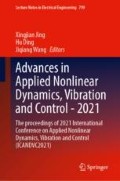Abstract
The parametric instability of an electromechanically coupled single-span rotor-bearing system subjected to periodic axial loads is studied. Here, the rotor system is equipped with two piezoelectric dampers, which has been developed in our previous work. The so-called electromechanically coupled characteristic is namely derived from that damper. By using assumed mode method and Lagrange equation, the equations of motion are derived. The multiple scales method is utilized to obtain the analytical instability boundaries. Numerical simulations based on the discrete state transition matrix method (DSTM) are conducted to verify the analytical results. With the comparison between analytical results and simulated results, we find that the additional combination instability regions are created due to the usage of piezoelectric dampers.
Access this chapter
Tax calculation will be finalised at checkout
Purchases are for personal use only
References
He H, Tan X, He J, Zhang F, Chen G (2020) A novel ring-shaped vibration damper based on piezoelectric shunt damping: theoretical analysis and experiments. J Sound Vib 468. https://doi.org/10.1016/j.jsv.2019.115125.
Tan X et al (2020) Dynamic modeling for rotor-bearing system with electromechanically coupled boundary conditions. Appl Math Model 91:280–296. https://doi.org/10.1016/j.apm.2020.09.042
Chen LW, Ku DM (1990) Dynamic stability analysis of a rotating shaft by the finite element method. J Sound Vib 143:143–151. https://doi.org/10.1016/0022-460X(90)90573-I
Takayanagi M (1991) Parametric resonance of liquid storage axisymmetric shell under horizontal excitation. J Press Vessel Technol Trans ASME 113:511–516. https://doi.org/10.1115/1.2928788
Dutt JK, Nakra BC (1992) Stability of rotor systems with viscoelastic supports. J Sound Vib 153:89–96. https://doi.org/10.1016/0022-460X(92)90629-C
Pei YC (2009) Stability boundaries of a spinning rotor with parametrically excited gyroscopic system. Eur J Mech A/Solids 28:891–896
Han Q, Chu F (2013) Effects of rotation upon parametric instability of a cylindrical shell subjected to periodic axial loads. J Sound Vib 332:5653–5661. https://doi.org/10.1016/j.jsv.2013.06.013
Han Q, Chu F (2015) Parametric instability of flexible rotor-bearing system under time-periodic base angular motions. Appl Math Model 39:4511–4522. https://doi.org/10.1016/j.apm.2014.10.064
Song Z, Chen Z, Li W, Chai Y (2016) Parametric instability analysis of a rotating shaft subjected to a periodic axial force by using discrete singular convolution method. Meccanica 52(4–5):1159–1173. https://doi.org/10.1007/s11012-016-0457-4
Qaderi MS, Hosseini SAA, Zamanian M (2018) Combination parametric resonance of nonlinear unbalanced rotating shafts. J Comput Nonlinear Dyn 13:1–8. https://doi.org/10.1115/1.4041029
Dai Q, Cao Q (2018) Parametric instability of rotating cylindrical shells subjected to periodic axial loads. Int J Mech Sci 146–147:1–8. https://doi.org/10.1016/j.ijmecsci.2018.07.031
Phadatare HP, Pratiher B (2020) Dynamic stability and bifurcation phenomena of an axially loaded flexible shaft-disk system supported by flexible bearing. Proc Inst Mech Eng Part C J Mech Eng Sci 234:2951–2967. https://doi.org/10.1177/0954406220911957.
Nayfeh AH, Mook DT (1979) Nonlinear oscillations. John Wiley, New York
Chen LQ, Zhang YL (2014) Multi-scale analysis on nonlinear gyroscopic systems with multi-degree-of-freedoms. J Sound Vib 333:4711–4723. https://doi.org/10.1016/j.jsv.2014.05.005
Author information
Authors and Affiliations
Corresponding author
Editor information
Editors and Affiliations
Appendices
Appendix A
The detailed expressions of \({\tilde{\mathbf{M}}}\), \({\tilde{\mathbf{G}}}\), \({\tilde{\mathbf{K}}}\), \(\stackrel{\mathrm{\sim }}{\text{D}}\), \(\stackrel{\mathrm{\sim }}{\text{S}}\), \({{\tilde{\mathbf{F}}}}_{\text{v}}\), \({{\tilde{\mathbf{F}}}}_{\text{w}}\) are given as follows:

where


where
and
Appendix B
For simplicity, only the mode vector ri is derived here and the derivation process of sk is similar. In Eq. (21a), the matrix equation can be detailedly expressed as
Assume r1i = 1, then the other elements of ri can be calculated by the following N − 1 linear algebraic equations
Rights and permissions
Copyright information
© 2022 The Author(s), under exclusive license to Springer Nature Singapore Pte Ltd.
About this paper
Cite this paper
Tan, X. et al. (2022). Parametric Instability of an Electromechanically Coupled Rotor-Bearing System Subjected to Periodic Axial Loads: A Preliminary Theoretical Analysis. In: Jing, X., Ding, H., Wang, J. (eds) Advances in Applied Nonlinear Dynamics, Vibration and Control -2021. ICANDVC 2021. Lecture Notes in Electrical Engineering, vol 799. Springer, Singapore. https://doi.org/10.1007/978-981-16-5912-6_42
Download citation
DOI: https://doi.org/10.1007/978-981-16-5912-6_42
Published:
Publisher Name: Springer, Singapore
Print ISBN: 978-981-16-5911-9
Online ISBN: 978-981-16-5912-6
eBook Packages: EngineeringEngineering (R0)

